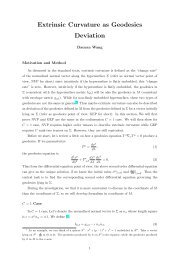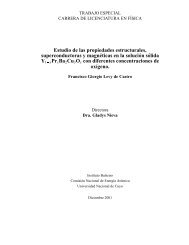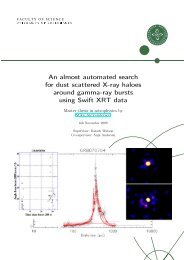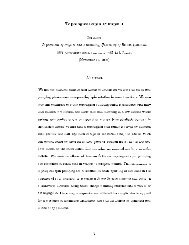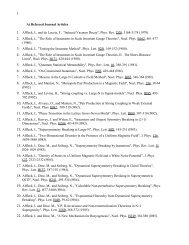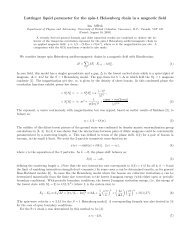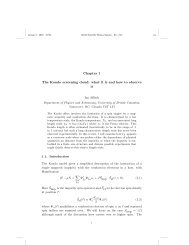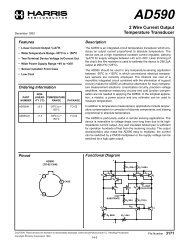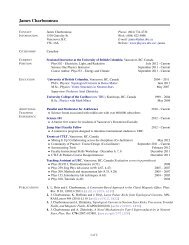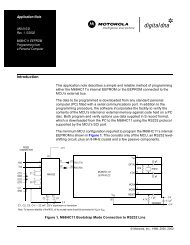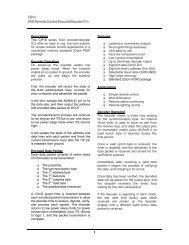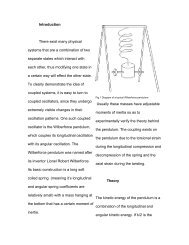The Henon-Heiles Hamiltonian
The Henon-Heiles Hamiltonian
The Henon-Heiles Hamiltonian
You also want an ePaper? Increase the reach of your titles
YUMPU automatically turns print PDFs into web optimized ePapers that Google loves.
<strong>The</strong> <strong>Henon</strong>-<strong>Heiles</strong><br />
<strong>Hamiltonian</strong><br />
Motion of Stars about a Galactic<br />
Center
<strong>The</strong> <strong>Henon</strong>-<strong>Heiles</strong> <strong>Hamiltonian</strong> describes the<br />
motion of stars around a galactic center, assuming<br />
the motion is restricted to the xy plane.<br />
2 2<br />
P P<br />
x y 1 2 2<br />
H = + + k(<br />
x + y ) + λ(<br />
x<br />
2m<br />
2m<br />
2<br />
2<br />
y−<br />
1<br />
3<br />
y<br />
3<br />
)
In order to simplify the <strong>Hamiltonian</strong> assume:<br />
P mx<br />
P x<br />
y<br />
= = my<br />
and<br />
And rewrite the <strong>Hamiltonian</strong> in a dimensionless, normalized form<br />
with lambda equal to one:<br />
E<br />
1<br />
2<br />
2 2<br />
= ( x<br />
+ y<br />
) +<br />
1<br />
( x<br />
2<br />
2<br />
+<br />
y<br />
2<br />
) + x<br />
This yields the following equations of motion:<br />
x<br />
= −x<br />
− 2xy<br />
2<br />
y−<br />
y = − y − x<br />
2 + y<br />
2<br />
and<br />
1<br />
3<br />
y<br />
3
A Poincare map is a two dimensional slice of a systems four<br />
dimensional phase space<br />
Poincare map for the<br />
double pendulum<br />
Beta is the angle between<br />
the first and second<br />
pendulums
Appropriate initial conditions are determined by the total energy of<br />
the system<br />
E<br />
1<br />
2<br />
2 2<br />
= ( x<br />
+ y<br />
) +<br />
1<br />
( x<br />
2<br />
2<br />
+<br />
y<br />
2<br />
) +<br />
x<br />
2<br />
y−<br />
1<br />
3<br />
y<br />
3<br />
We will be examining Poincare sections in the y y<br />
so initially we may set x=0<br />
E<br />
1<br />
2<br />
2 2<br />
= ( x<br />
+ y<br />
) +<br />
1<br />
2<br />
y<br />
2<br />
−<br />
1<br />
3<br />
y<br />
3<br />
plane,
<strong>The</strong> bounding curve for the available phase space can be determined<br />
by setting x=0<br />
E<br />
1<br />
= y<br />
2<br />
2<br />
+<br />
1<br />
2<br />
y<br />
2<br />
−<br />
1<br />
3<br />
y<br />
3<br />
If we choose values of y and y that lie within this bounding<br />
Curve, we may use the equation<br />
x = +<br />
2<br />
3<br />
2 2<br />
3<br />
( 2 E − y − y y<br />
This gives us our appropriate set of initial conditions<br />
)<br />
1<br />
2
2 2<br />
y = − y − x + y<br />
x<br />
= −x<br />
− 2xy<br />
In order to solve these equations we will first cast them into<br />
canonical, first order form<br />
y<br />
y<br />
y<br />
y<br />
1 1 3<br />
<strong>The</strong>se four first<br />
2<br />
3<br />
4<br />
=<br />
=<br />
=<br />
=<br />
x<br />
y<br />
x<br />
y<br />
y<br />
y<br />
y<br />
y<br />
2<br />
3<br />
4<br />
′<br />
′<br />
′<br />
′<br />
=<br />
=<br />
=<br />
=<br />
y<br />
y<br />
−<br />
−<br />
4<br />
y<br />
y<br />
1<br />
2<br />
−<br />
−<br />
2<br />
y<br />
y<br />
2<br />
1<br />
1<br />
y<br />
+<br />
<br />
2<br />
y<br />
2<br />
2<br />
order equations<br />
may now be<br />
integrated using<br />
the Fortran<br />
routine LSODA
Poincare section for E=1/12<br />
Four regions with elliptical orbits<br />
At the center of each region<br />
is an elliptical fixed point<br />
Where the boundary of each<br />
region meets is a hyperbolic<br />
point
If we increase the energy to E=1/8 we start to see chaotic behavior<br />
<strong>The</strong>re are still “islands”<br />
of non-chaotic behavior<br />
with elliptic fixed points<br />
At their centers<br />
However, the regions<br />
between these islands are<br />
now filled with a completely<br />
random set of points<br />
generated from a single set<br />
of initial conditions<br />
<strong>The</strong>se bounded areas of chaos are cross sections of a strange<br />
attractor
If the energy is increased to E=1/6 the strange attractor pretty<br />
much fills up all of the available phase space<br />
This Poincare map<br />
was created with<br />
a single set of<br />
initial conditions



